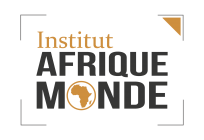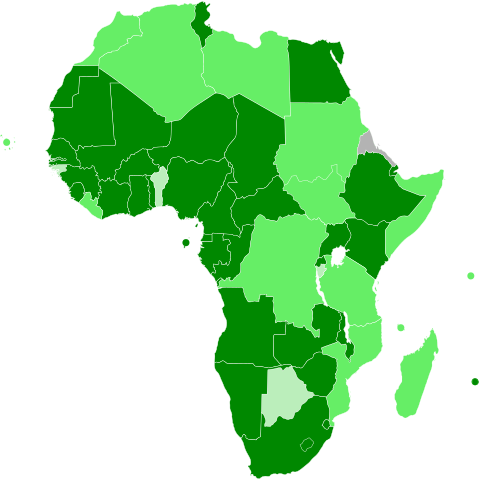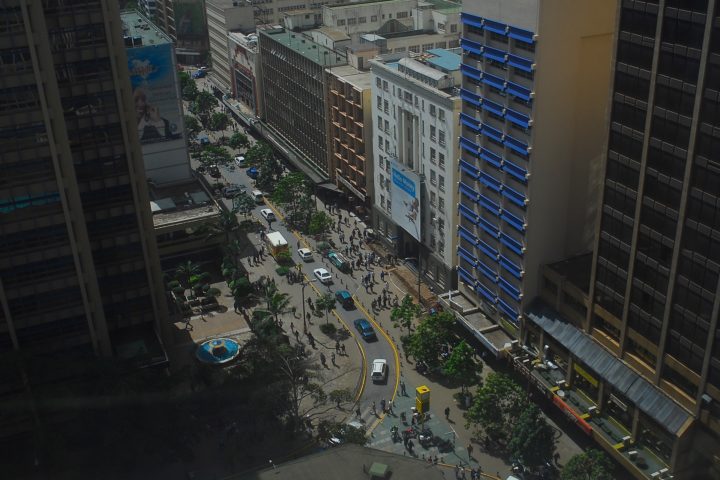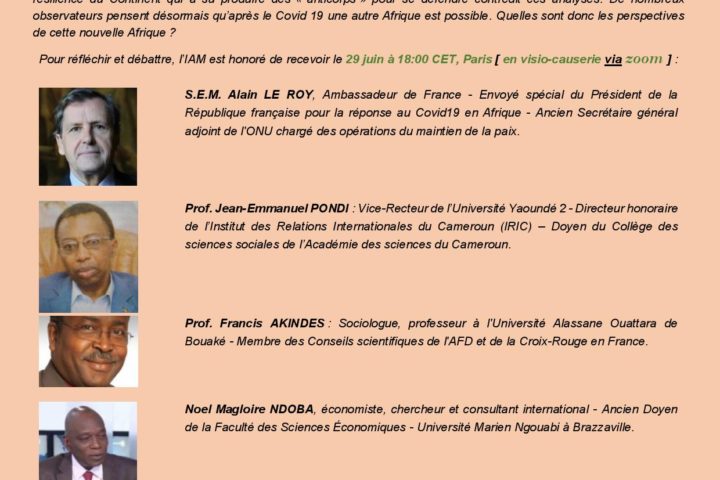
Aminata DIABY
Doctoral student in international economic law – University of Burgundy
I The beginnings of African integration
The time has come for the endogenous development of the African continent. Institutional, economic and environmental development is necessary in order to promote the growth of the African continent on the international scene. Africa has the technical and human means to increase and dispose of its resources intelligently. However, their exploitation depends mainly on the development and proper implementation of regional agreements that take into account issues related to good governance and institutional mechanisms specific to the continent.
“The Africa we want” was the motto associated with Agenda 2063 when it was adopted at the end of the 24th Summit of Heads of State and Government of the African Union in 2015. This Agenda was developed to define the action plan of member states for the next fifty years. The African Continental Free Trade Area (AfCFTA) is one of the main objectives of Agenda 2063 for the sustainable integration of the African continent. This objective is in line with aspiration 2: “A continent that is integrated, politically united and anchored in the ideals of pan-Africanism and the vision of the African renaissance” [1]. Strategically, the division into ten-year plans makes it possible to set major milestones at each deadline, ultimately collaborating to achieve all the aspirations. The establishment of the FTAA is part of the first ten-year plan of the Agenda, underlining the priority it has been given.
By definition, a free trade area implies the free movement of goods (and services if the agreement so stipulates) through the lowering of tariff and non-tariff barriers within the area in question. Moreover, in this configuration, each member country retains its own customs system vis-à-vis countries outside the zone, making the integration process less binding.
The institutionalization of the African continent has been gradual, but not without difficulty. The project was carefully thought out beforehand, thanks to the various meetings of the leaders of the Southern countries [2]. The challenges encountered have allowed for a strategic readjustment over the decades, which has led the States to show resilience and imagination in order to consolidate their cooperation projects, without abandoning their ideologies of unity and “living together”. It is clear that the desire to unify the African continent through economic and political integration, based on cooperation, appeared as early as the 1950s. The Bandung conference in 1955 marked a decisive step in the maturity of cooperation and institutionalization projects. The succession of different waves of decolonization pushed the States to carry out an inter-State reflection on their endogenous development, as well as on the attitude to adopt together before the international scene. Insofar as the ideals on which the founding fathers [3] wanted to lay the foundations of the continent diverged from those at work in the East and West [4].
II The challenges of newly acquired independence
-
Sovereignty and state cooperation – what are the links?
Two spheres of influence were then on the agenda: without denying the desire for increased co-operation on both sides, that is, in an institutional form, not everyone agreed on the final form to be adopted: “on the one hand, the very integrationist and federalist thesis of Ghana, the creation of a true African state structure with two chambers (one representing the states, the other the peoples) and an African continental government; on the other hand, the very interstate thesis of Ethiopia (and the majority of the Monrovia group) for the creation of a very flexible structure of cooperation respecting the full sovereignty of the states” [5]. Newly independent, it is understandable that the African states do not want this newly acquired sovereignty to be transferred to a third organization, even if this was intended to boost, among other things, the economic development and catch up that they had to face once independent. This led to the creation of the Organization of African Unity (OAU). With it came the adoption of the Abuja Treaty in 1991 [6], establishing the African Economic Community, which aims to achieve a continental customs union (CU), to which all the sovereign states of the Organization would be party. This is a major project that requires major institutional reforms, particularly at the level of regional economic communities (RECs). However, the constitution of a customs union requires a preliminary step. Indeed, it is first necessary to lay the foundations of the edifice. A customs union is a relatively advanced stage of economic integration, requiring additional adjustments and strong support from the member states – implying a transfer of sovereignty to the international organization in order to guarantee its efficiency. It presupposes a common trade policy for all member states. It was therefore necessary to go through an intermediate stage. This stage was only achieved with the creation of the African Union in 2002 as a successor to the OAU.
To return to the creation and evolution of the OAU and the failure of the Customs Union, it should be noted that it was not easy. As a fledgling international organization, made up entirely of newly independent countries, border disputes had to be reckoned with to slow down the institutional process [7]. Issues that prevented the organization from focusing on economic development between 1965 and 1966. This was an opportunity for other international organizations to compete with it. For example, the Organization of African and Malagasy Cooperation (OCAM), which initially grouped together the former French-speaking colonies, was a significant shadow for the inter-state organization. Even if the latter denied any desire to compete with the OAU as an international organization, it opened the door to all African states wishing to join via its Charter [8]. This competition had its good sides, however. It allowed certain States to make progress on other practical aspects of State cooperation, while the OAU, with “good offices”, tried to ensure that the rules of its constitutive Charter, inspired in particular by Article 2 of the United Nations Charter, were respected. Reaffirming therefore, on many occasions, the principles of sovereign equality and peaceful settlement of disputes. The agenda of the OCAM meetings often clashed with that of the OAU meetings in the mid-1960s, leading to fears that the OAU would become obsolete. This phenomenon of regionalism was also observable in East, Equatorial and Central Africa. The various organizations in place have, at their own level, contributed to the evolution of the technical and practical aspects of sub-regional inter-state cooperation, while waiting for a possible effective collaboration on a larger scale.
It is therefore understandable that the difficulties encountered in the institutional construction of the OAU, with diplomatic and political problems on the one hand, and the desire of States to preserve their hard-won sovereignty on the other, did not constitute an environment conducive to the creation of a continental customs union.
-
Primary economies
The other aspect that made it impossible to establish a viable FTA or DU at that time was the lack of diversification of the various economies within the continent. Mainly exporters of raw materials, rather than processed materials, the states would have found themselves in a scenario of competition rather than complementarity regarding inter-African trade [9]. From that point on, a diversification of economies was necessary. Today, this is still an issue, as African economies are not fully diversified and “clientelism” towards the States of the North or other States of the South, such as China, is still strongly marked. This is a criticism often put forward concerning the future functioning of the AfCFTA.
III From signature to entry into force of the FTAA: a laborious process
The establishment of the FTAA is, in itself, a highly ambitious project that has encountered difficulties from the outset. While it is an undertaking, it remains realistic because in terms of regional integration, the free trade area is the stage that precedes the customs union [10]. Ultimately, the goal to be achieved by 2053 is “an integrated, prosperous and peaceful Africa, managed by its own citizens and representing a dynamic force in the international arena” [11].
This project was formalized by the adoption of an agreement entitled “Agreement on the Establishment of the African Continental Free Trade Area” signed in Kigali on March 21, 2018. All member states of the African Union except Eritrea [12] are signatories. However, only 34 of them have ratified the agreement to date. It is clear that the treaty has had difficulty entering into force and obtaining the minimum number of ratifications required since its creation [13]. One of the major difficulties has been to obtain the adhesion of an economic and protectionist weight such as Nigeria. Ratification of the agreement by this state came almost a year and a half after its signature. However, this can be considered a first victory for this project that promotes a strong liberalization of trade, with a very tight schedule (mostly over a decade). This demonstrates, in fine, a strong adherence to the pan-African ideals promoted by Agenda 2063, as outlined above. The global pandemic due to the Covid-19 virus has also had an impact on the launch of the Zone. Initially scheduled for July 2020, it was postponed to January 2021.
With the adoption of this treaty, the African Union has set eight main objectives, directly inspired by the guidelines of its Agenda 2063. The objectives set are as follows [14]:
- The creation of a single market for goods, services, as well as the free movement of people to strengthen the integration of the African continent. This is in line with the pan-African vision set out in Agenda 2063;
- The establishment of successive rounds of negotiations to prepare for the liberalization of goods and services;
- Encouragement of the movement of capital and natural resources, as well as investments and development initiatives taken by the States Parties and regional economic communities;
- The development of the basis for a continental customs union;
- The promotion of socially and economically inclusive sustainable development, gender equality and structural transformation of the member states;
- The improvement of the competitiveness of the economies of the States Parties on the continent and on the world market;
- Promoting industrial development through diversification and development of regional value chains, agricultural development and food security;
- Resolving the challenges of multiple memberships in the RECs and the overlap of their competencies in order to accelerate integration.
From the outset, it is clear that this is not a classic free trade area in terms of certain objectives. Indeed, it includes a section on the free movement of persons, which is unusual for an agreement on a free trade area. Moreover, the free movement of persons is already not evident at the sub-regional level, and to carry it out at the regional level, as provided for in the protocol attached to the FTAA agreement, seems utopian for the time being [15]. The question that arises is this: shouldn’t the negotiations on the liberalization of goods and services be completed and properly implemented before considering the free movement of people? According to David Luke, coordinator of the African Trade Policy Centre, the free movement of people is essential for the proper functioning of the FTAA [16], which seems to be a legal and economic curiosity. This free movement of people is in line with the perspective of technical and cultural cooperation, initiated by the South-South Cooperation movement. It is reasonable to imagine that this provision is strongly complementary in the construction of this African international law that takes up pan-African ideals and advocates integration. We are witnessing a new wave of regional trade agreements that automatically integrate social dimensions into their structures, at least as far as the African continent is concerned.
IV The challenges of this continental free trade area
Through this FTAA, AU member states are starting a regional integration process that will lead to the creation of a customs union that will promote the prosperous and unified development of Africa. African states import and export a great deal to non-African states, and intra-African trade is very poor compared to intra-regional trade in other regions of the world [17]. The objective is therefore to make most of the capital circulate between the States parties to the FTAA and make the continent more resilient [18]. As we have seen with the Covid-19 pandemic crisis, the UN estimated in March 2020 that the context would be a “severe blow” to African economies. However, it made a recommendation that was not insignificant, that of promoting intra-African technical cooperation encouraged by the rapid implementation of the FTAA. The UN considered that the postponement of the launch to January 2021 was not desirable. However, this postponement was necessary because the complex negotiations conducted by the States had fallen behind schedule, particularly those on key points such as the rules of origin, which they agreed to set at a minimum before the launch of the Zone.
The African states will face numerous problems such as the loss of budgetary revenue generated by the lowering of tariff barriers [19]. Notwithstanding this, in the long term, the benefits resulting from the movement of capital could lead to a boost in trade and an increase in the standard of living of citizens if the wealth is equitably redistributed. According to the African Economic Commission for the United Nations, the FTAA “aims to become the world’s largest trading bloc and generate a market of more than 1.2 billion consumers.” [20]. The success of this FTAA will therefore be beneficial for the insertion of the States parties in this multipolar world.
Conclusion
To date, the FTAA is a gateway to the regional integration so desired by the member states. This regional and economic integration can be seen as a means of achieving the African unity sought since independence. A unified vision of Africa based on solidarity. A door that must not be allowed to close. However, there are many challenges, relating to the economy, good governance and institutionalization, which weigh on the success of this zone.
[1] https://au.int/en/agenda2063/aspirations
[2] African, Asian and South American leaders met in Bandung in order to reaffirm their desire for independence and emancipation in a context of tension caused by the war being waged by the two blocs (Cold War). From there, the Non-Aligned Movement and the doctrine of South-South Cooperation were born, which contributed to the reflection on the institutional development of the African continent.
[3] Leaders such as N’Krumah, Selassie, Nasser, Sekou-Toure…
[4] CONSTANTIN François, “L’intégration régionale en Afrique noire : État des travaux”, Revue française de science politique 22, no 5 (1972): 1074-1110, https://doi.org/10.3406/rfsp.1972.418949. “The values of unity prevailing over individualism; the promotion of social progress in economic development…
[5] BORELLA François, “Le régionalisme africain et l’Organisation de l’Unité Africaine”, Annuaire Français de Droit International 9, no 1 (1963): 838‑65, https://doi.org/10.3406/afdi.1963.1061.
[6] Treaty ratified in 1994 by the States of the Organization of African Unity (OAU), with just the minimum required. There are similarities in this respect with the FTAA.
[7] Examples: Rhodesian conflict; Algerian-Moroccan conflict…
[8] BORELLA François, “Le régionalisme africain en crise (1965-1966)”, Annuaire français de droit international 12, no 1 (1966): 756‑83, https://doi.org/10.3406/afdi.1966.1904.
[9] CONSTANTIN François, “L’intégration régionale en Afrique noire”. Revue française de science politique, 1972.
[10] BELASSA Bela, The theory of economic integration (1961).
[11] https://au.int/sites/default/files/documents/33126-doc-06_the_vision.pdf
[12] See the African Union website, “status list” section
[13] Minimum ratification reached thanks to Gambia (22nd ratification) in April 2019. The treaty enters into force in May 2019 https://www.agenceecofin.com/economie/0404-65153-avec-la-22e-ratification-gambie-la-zelca-sera-officiellement-adoptee-au-sommet-de-l-ua-de-niamey-en-juillet-prochain
[14] https://au.int/en/african-continental-free-trade-area
[15] The protocol has not yet entered into force.
[16] https://afrimag.net/zlecaf-libre-circulation-personnes-est-essentielle/
[17] “In 2019, 14.4% of official African exports went to other African countries, a small proportion compared to 52% of intra-Asian trade and 73% between European nations in the same year […]”, PILLING David, “Zlecaf: les pays africains ne sont pas prêts”, in Jeune Afrique, Jan. 2021.
[18] See TALL SALL Aïssata: “The Zlecaf would be a great opportunity to reduce the continent’s high dependence” in La Tribune Afrique, March 2021.
[19] ESSAMA MEKONGO Pierrette “Enjeux et défis de la mise en œuvre de la zone de libre-échange africaine”, The Conversation, July 2019.
[20] See ECA: “AfCFTA: Joint and pragmatic efforts needed for Sudan to benefit from its strengths”, Dec. 2020.




